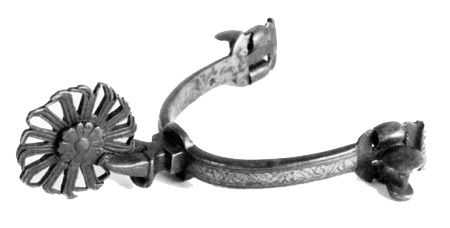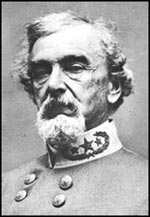
|

Spring 2002 CourierSpur Was Silent Witness to Wars, Indian Campaign
The photograph above and the following article are reprinted with permission from History Notes, the newsletter of the Virginia Historical Society. Among the items acquired recently by the Virginia Historical Society was a unique piece of American history, an early 19th century spur, donated by the Edward and Aurelia Brown family. The Huger spur, as it is known, was in the possession of one Virginia family fo rmore than a century an da half and was a silent witness to battles in the Mexican-American War, the Civil War, and the Indian campaigns of the late 19th century. The Huger spur was crafted of steel, probably in the 1840s, with a gold-inlaid band intricately engraved with trailing vines. The multi-spoked rowel, or wheel, is renderd as a flower, with the petals forming the points on the spur. Although its origin is unknown, it was most likely made in Mexico or Cuba, where its first owner, Mexican general Antonio Lopez de Santa Anna, was living in exile before the Mexican-American War. The first documented account of the Huger spur dates from September 1847 after Santa Anna's defeat at the hands of General Winfield Scott In Mexico City. Santa Anna surrendered his sword to Scott, who, in a gesture of respect, promptly returned it. To show his appreciation, Santa Anna removed his spurs and presented them to Scott. Soon thereafter, Scott gave them to his chief of ordnance and artillery, Captan Benjamin Huger, for bravery at Vera Cruz, Molino del Rey, and Chapultepec.
Some months after the war, Custer wrote to Huger asking permission to keep the spurs a little longer. Huger agreed, and Custer took the spurs when he went out west to fight in the Indian campaigns from which he never returned. One of the spurs was reportedly recovered from Custer's body after the Battle of Little Big Horn and given to his widow, Elizabeth, who then returned the spur to Frank Huger. Personal papers and manuscripts that document the travels of the Huger spur lend credence to its seemingly fantastic history. |
You Are Here: Home > Essays and Artifacts > Insights from The Courier > Spring 2002 > History of the Huger Spur |
 Huger
gave the spurs to his son Frank on his graduation from West Point. The
following year both Hugers resigned their commissions in the United
Staes Army to serve Virginia and the Confederacy. The elder Huger commanded
state forces in Norfolk and eventually gained promotion to major general.
Frank Huger fought with the Norfolk Light Artillery, known as Huger's
Battery, and quickly moved up in the ranks after service in the battles
of the Seven Days, Sulphur Springs, Harpers Ferry, and Fredericksburg.
In 1863 he was promoted to major and fought at Chancellorsville and
Gettysburg. By the end of that year, he was a colonel in command of
his own battalion. He was captured at Saylor's Creek in April 1865 by
General George Armstrong Custer, a friend from West Point. Knowing that
the war was over for him, the Virginian lent his prized spurs to the
flamboyant Federal officer.
Huger
gave the spurs to his son Frank on his graduation from West Point. The
following year both Hugers resigned their commissions in the United
Staes Army to serve Virginia and the Confederacy. The elder Huger commanded
state forces in Norfolk and eventually gained promotion to major general.
Frank Huger fought with the Norfolk Light Artillery, known as Huger's
Battery, and quickly moved up in the ranks after service in the battles
of the Seven Days, Sulphur Springs, Harpers Ferry, and Fredericksburg.
In 1863 he was promoted to major and fought at Chancellorsville and
Gettysburg. By the end of that year, he was a colonel in command of
his own battalion. He was captured at Saylor's Creek in April 1865 by
General George Armstrong Custer, a friend from West Point. Knowing that
the war was over for him, the Virginian lent his prized spurs to the
flamboyant Federal officer.